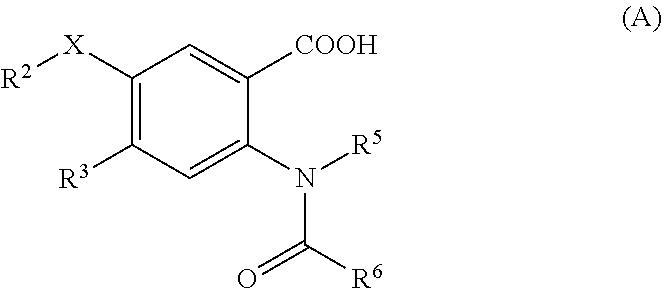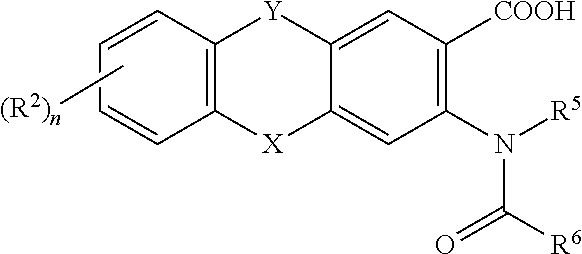Viral polymerase inhibitors
- Summary
- Abstract
- Description
- Claims
- Application Information
AI Technical Summary
Benefits of technology
Problems solved by technology
Method used
Image
Examples
example 1a
Compound 1004
[0303]
Step1:
[0304]Add anhydrous potassium carbonate (4.83 g, 34.9 mmol) to a mixture of chloro-nitro areae (1a1, 4.98 g, 23.1 mmol) and 2-bromophenol (1a2, 3.4 mL, 29.3 mmol) in DMSO (30 mL) and heat for about 6 h at 80° C. Bring the mixture to RT and leave at RT for about a further 16 h. Dilute the mixture with water (150 mL) and extract with t-BME (3×100 mL). Combine the organic portions, and wash successively with 1 N NaOH (aqueous, 2×50 mL), water (50 mL), and brine (50 mL). Subsequent drying with anhydrous MgSO4, filtering, and evaporation of the volatiles provides 1a3.
Step 2:
[0305]Dissolve 1a3 (7.00 g, 19.9 mmol) into a mixture consisting of EtOH (80 mL), water (11 mL) and saturated NH4Cl (aqueous, 11 mL). Add iron powder (3.33 g, 59.6 mmol) in one portion and heat for about 7 h at 80° C. Add another portion of iron powder (2.30 g, 41.2 mmol) to the mixture and continue heating for about a further 9 h. Dilute with EtOAc and filter the solids. Collect the filtrate ...
example 1b
Compound 1005
[0312]
Step 1;
[0313]Add 1a6 (30 mg, 0.11 mmol) to concentrated sulfuric acid (0.4 mL) and immerse in a sonication bath for about 30 min. Add water (4.6 mL) and filter the solids to afford 1b1.
Step 2;
[0314]To a mixture of 1b1 (21 mg, 0.058 mmol) in anhydrous pyridine (2 mL) under an Ar atmosphere, add DMAP (1 mg, 0.007 mmol) and 1a8 (57 mg, 0.35 mmol). Heat to 60° C. for about 25 h. Evaporate the volatiles and dissolve the residue in DMSO (1 mL). Add 5 N NaOH (aqueous, 0.2 mL) and heat to 50° C. for about 1.6 h, then leave at RT for about 18 h. Add excess TFA until the pH is approximately <2. Purification affords 1005.
example 1c
Compound 1012
[0315]
Step 1:
[0316]Add to a mixture of 3-broma-4-fluoronitrobenzene (1c1, 245 mg, 1.12 mmol) and 1c2 (synthesis according to the procedure in WO 2007 / 087717) (264 mg, 0.79 mmol) in DMSO (2.8 mL), anhydrous potassium carbonate (154 mg, 1.11 mmol) and stir at 85° C. for about 2.5 h. Dilute the mixture with t-BME and wash successively with 1 N NaOH (aqueous), water and brine. Subsequently, dry with anhydrous MgSO4, filter, and evaporate the volatiles. Purification by flash chromatography (EtOAc / Hexanes) provides 1c3,
Step 2:
[0317]Reference: Keith Fagnou et al., J. Am. Chem. Soc. 2006, 128, 581-590.
[0318]Stir a mixture consisting of 1c3 (750 mg, 1.41 mmol), potassium carbonate (582 mg, 4.21 mmol), tricyclohexylphosphine tetrafluoroborate (108 mg, 0.28 mmol) and DMA (7 mL) at RT while bubbling Ar gas through the mixture for about 15 min. Add palladium(II)acetate (68 mg, 0.29 mmol) and immerse the reaction vessel into an oil bath preheated to 130° C., while maintaining a stati...
PUM
| Property | Measurement | Unit |
|---|---|---|
| Mass | aaaaa | aaaaa |
| Mass | aaaaa | aaaaa |
| Mass | aaaaa | aaaaa |
Abstract
Description
Claims
Application Information
 Login to View More
Login to View More - R&D
- Intellectual Property
- Life Sciences
- Materials
- Tech Scout
- Unparalleled Data Quality
- Higher Quality Content
- 60% Fewer Hallucinations
Browse by: Latest US Patents, China's latest patents, Technical Efficacy Thesaurus, Application Domain, Technology Topic, Popular Technical Reports.
© 2025 PatSnap. All rights reserved.Legal|Privacy policy|Modern Slavery Act Transparency Statement|Sitemap|About US| Contact US: help@patsnap.com



